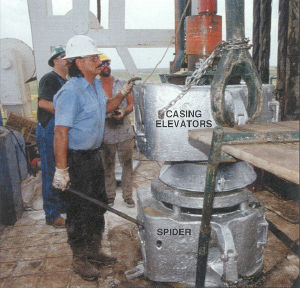Oil and Gas Well Drilling and Servicing eTool
Drilling » Casing Operations

Casing is pipe usually larger in diameter and longer than drill pipe and is used to line the hole. Casing operations occur periodically throughout the drilling process starting with the surface casing, intermediate casing, and ending with production string which takes place during well completion.
The activities involved in casing operations can vary according to the type of casing being installed, but generally fall into these steps:


Specialized casing handling tools are necessary to run casing.
Note: The special service supervisor should hold a pre-job meeting with the special service crew and other involved personnel to review responsibilities and to coordinate the operations to be performed.
Potential Hazards
- Being struck by or caught between tubulars and other objects during movement (such as being struck by tubulars being tailed into the rig floor).
- Experiencing strains and sprains from maneuvering tools.
- Falling from work platform and/or stabbing board.
Possible Solutions
- Stand clear of suspended, hoisted or moving loads. Be aware of tubulars or equipment being lifted through the V-door.
- Use proper hand and foot placement to avoid pinch points, including use of tag lines.
- Use rig floor winch or other powered equipment to handle heavy casing tools.
- Use fall protection while installing equipment in the derrick.
- See Slips, Trips, and Falls.


Casing is run into the hole to a pre-determined depth.
Note: The special service supervisor should hold a pre-job meeting with the special service crew and other involved personnel to review responsibilities and to coordinate the operations to be performed.
Potential Hazards
- Hazards are similar to those for drilling ahead or tripping.
- Getting caught between, struck by, or pinched by the power tongs, casing or other equipment.
- Being struck by or caught between tubulars and other objects during movement (for example, struck by tubulars being tailed into the rig floor).
- Falling from the stabbing board or work platform.
- Getting struck by dropped objects.
Possible Solutions
- Include the casing crew and the drilling crew when conducting a JSA and pre-job safety meeting to coordinate the activities of casing operations.
- Stand clear of suspended, hoisted, or moving loads. Be aware of tubulars or equipment being lifted through the V-door.
- Emphasize all normal worker safety procedures, such as fall protection, personal protective equipment, placement of hands and feet, and teamwork and communication between workers.
- Implement full fall protection program for the casing stabber.
- Identify clearance between the stabbing board and casing elevators.
- Secure all items used by the casing stabber overhead with a safety line.
#59. Tongs
The large wrenches used for turning when making up or breaking out drill pipe, casing, tubing, or other pipe; variously called casing tongs, rotary tongs, and so forth according to the specific use. Power tongs are pneumatically or hydraulically operated tools that spin the pipe up and, in some instances, apply the final makeup torque.†



As casing is being run, accessories such as centralizers, scratchers, guide shoe, and a float collar are installed and used as needed.
Note: The special service supervisor should hold a pre-job meeting with the special service crew and other involved personnel to review responsibilities and to coordinate the operations to be performed.
Potential Hazards
- Dropping guide shoe or float collar onto legs or foot.
- Getting fingers pinched between tools and casing tongs when manually moving guide shoe or float collar.
- Back strain
- Exposure to hazardous materials, especially thread lock compounds.
Possible Solutions
- Use winch, air hoist, or other powered equipment to handle guide shoe, float collar, or other heavy casing equipment.
- Use appropriate personal protective equipment as required by the SDS.

After the casing is landed, drilling fluid is circulated through the casing and annulus to remove any residual gases and to condition the mud.
After circulating and conditioning the mud, the casing is cemented. During this process the casing is reciprocated or rotated to allow the scratchers to work to remove excess wall cake to give the cement a better bond.
Usually another special servicing company is hired to conduct cementing operations.
Potential Hazards
- Being struck by high-pressure lines failing if not secured properly.
- Having a high pressure connection failure caused by mismatched or excessively worn hammer unions.
Possible Solutions
- Hobble high-pressure lines properly.
- Use proper equipment inspection techniques to include hammer unions (Note: This is a particular problem with 602 and 1502, as they will couple but will not hold beyond the lower pressure rating number).
- Safety Alerts. International Association of Drilling Contractors (IADC).
- High Pressure Lines And Hammer Unions. Alert 98-01, (April 1998).
- More On Mismatched Hammer Unions. Alert 99-33, (November 1999).
- Additional Serious Incidents With Mismatched Hammer Unions. Alert 00-15, (May 2000).
- Mismatched Hammer Unions Still Being Found. Alert 03-16, (April 2003).
- Mismatched Hammer Union Results in a Fatality. Alert 06-01, (January 2006).

